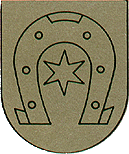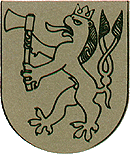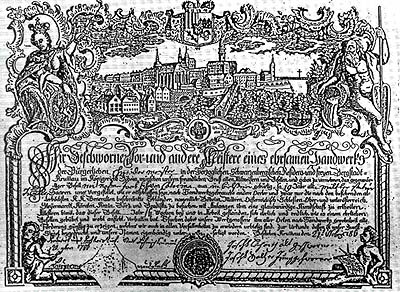History of Guilds and Crafts in Český Krumlov
Written sources collected in the State Regional Archive in Český Krumlov register a total 26 formerly existing guilds. Alimentary crafts included butchers (first written mention appeared in 1347), malters (1516), millers (1578), bakers (1595) and gingerbread bakers (1652). Textile crafts were represented by cloth makers (1430), tailors (1489), weavers (1538), hatters (1585), dyers (1705) and stocking makers (1679). Leather crafts included cobblers (1481), tanners (1545), furriers (1553), saddlers (1628) and belt makers (1661). Stonemasons, bricklayers and carpenters (1564) dealt with construction and building crafts and cooperated with other related crafts of joiners and coopers (1561), locksmiths, gun makers and cutlers (1546), blacksmiths and wheelrights (1555). Other crafts united potters (1538), ropemakers (1582), glassworkers (1651), soap boilers and candle makers (1714), shopkeepers, tradesmen (1699) and purchasers (1840).

|

|

|

|
The oldest rules used by nobility to establish guilds in towns
come from the 1st half of the 15th century, i.e. from the Rosenberg
era. The increasing number of craftsmen and crafts had reached such
a level that an urgent need of united organization and
administration arrived. Guild rules provided the guilds and
craftsmen with protection against unwanted competition from foreign
masters and illegal producers. There was a so-called mile law that
guaranteed a one mile circle around the town which was free of
foreign trade. Nevertheless, town  guilds accepted members
coming from other neighboring localities where the guilds did not
exist. This was a good way for them to protect themselves against
undesirable competition and to gain more fees from new members. We
can mention the weavers from the small village of Přídolí that had
their authority enlarged by their superior guild in Český Krumlov
in 1684 and then, in 1688, started to protest against the separate
guild establishment in Přídolí. From 1707, the hatters from Vimperk
and Drslavice demesne belonged to the hatter´s guild in Český
Krumlov, followed its orders and therefore were able to attend the
fairs and weekly markets in Husinec. Craftsmen from Český Krumlov
sought for some new outlets as well. In 1729, the tanner´s and
shoemakers´ guild from Chvalšiny complained about the craftsmen
from Český Krumlov and Horní Planá which had supposedly broken the
mile law and offered their goods in Kriš. Eventually, they made an
agreement that two craftsmen from Český Krumlov and Horní Planá
would go to the St. Thomas fair and Eastern Sunday fair in Ktiš,
and two craftsmen from Chvalšiny would attend the fairs in Světlík
and Zátoň. Competition often apeared even among single crafts.
Butchers were trying to solve disputes on house slaughter
permissions which harmed those united in the guild; butchers and
tanners argued with shoemakers about leather sales. Bakers fought
with groaters about illegal baking and sale of bread. Tailors had
similar troubles with furriers and cloth cutters who stole the work
belonging just to tailors and therefore deprived them of their
earnings.
guilds accepted members
coming from other neighboring localities where the guilds did not
exist. This was a good way for them to protect themselves against
undesirable competition and to gain more fees from new members. We
can mention the weavers from the small village of Přídolí that had
their authority enlarged by their superior guild in Český Krumlov
in 1684 and then, in 1688, started to protest against the separate
guild establishment in Přídolí. From 1707, the hatters from Vimperk
and Drslavice demesne belonged to the hatter´s guild in Český
Krumlov, followed its orders and therefore were able to attend the
fairs and weekly markets in Husinec. Craftsmen from Český Krumlov
sought for some new outlets as well. In 1729, the tanner´s and
shoemakers´ guild from Chvalšiny complained about the craftsmen
from Český Krumlov and Horní Planá which had supposedly broken the
mile law and offered their goods in Kriš. Eventually, they made an
agreement that two craftsmen from Český Krumlov and Horní Planá
would go to the St. Thomas fair and Eastern Sunday fair in Ktiš,
and two craftsmen from Chvalšiny would attend the fairs in Světlík
and Zátoň. Competition often apeared even among single crafts.
Butchers were trying to solve disputes on house slaughter
permissions which harmed those united in the guild; butchers and
tanners argued with shoemakers about leather sales. Bakers fought
with groaters about illegal baking and sale of bread. Tailors had
similar troubles with furriers and cloth cutters who stole the work
belonging just to tailors and therefore deprived them of their
earnings.
Organizational guild structure was arranged by special rules - a head of a guild was elected for a one-year term; the guild set up conditions for accepting newcomers, determined the number of years obligatory for each journeyman to spend at different towns or abroad, regulated the number of apprentices and journeymen (i.e. tailor's guild was rejecting the idea of accepting both new apprentices and masters in the 18th century, since there had been so many tailors in town and therefore not enough work for all of them), awarded masterships, and, other than that, it cared for senior or crippled craftsmen. The Rosenbergs supported guild establishments in town and provided the craftsmen with better conditions to carry on their jobs. Consequently they supported both the development of their residence town and the better lifestyle of its inhabitants. The advantages and protection provided were of course charged from a part of the craftsmen's incomes.
The historical center of Český Krumlov now may serve as a living reminder of the dexterity and skillfulness of the local craftsmen.
(jmi)
Further information:
History
of Meat Market in Český Krumlov
History
of Slaughterhouse in Český Krumlov


